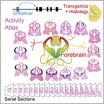(Press-News.org) January 31, 2013, Shenzhen, China – In a study published today in Science, researchers from University of Utah, BGI, and other institutes have completed the genome sequencing of rock pigeon, Columba livia, among the most common and varied bird species on Earth. The work reveals the evolutionary secrets of pigeons and opens a new way for researchers to study the genetic traits controlling pigeons' splendid diversity. The findings also help to fill the genetic gaps in exploiting pigeon as a model for the molecular genetic basis of avian variation.
People are quite familiar with the homing pigeon that carried vital messages back and forth in the war period. These "war pigeons" which have been trained to carry messages are domesticated rock pigeons. Pigeons are common birds found in many parts of the world and have more than 350 breeds with different sizes, shapes, colors, color patterns, beaks, bone structure, vocalizations and arrangements of feathers on the feet and head–including head crests that come in shapes known as hoods, manes, shells and peaks.
To study the genetic basis of the diversity of pigeon, researchers sequenced a pigeon breed named Danish tumbler as the reference genome, and re-sequenced additional 36 domestic breeds and two feral pigeons by next-gen sequencing technology. It is learned that the pigeon is among the few bird genomes sequenced so far, along with those of the chicken, turkey, zebra finch and parrot, which will give researchers new insights into bird evolution.
Researchers could know more about the origin of pigeons with more available genomic resource. Previous studies provided limited evidence of pigeon's origin in the Middle East and some breeds' origin in India, and indicated kinship between common feral or free-living city pigeons and escaped racing pigeons. With additional genomic data in this study, the researchers found there are a lot of shared genetic heritage between the breeds from Iran and the breeds that are suspected from India, which is consistent with historical records of trade routes between those regions. These analyses indicate that major pigeon breed groups all originated in the Middle East.
They also analyzed partial genomes of two feral pigeons: one from a U.S. Interstate-15 overpass in the Salt Lake Valley, and the other from Lake Anna in Virginia. Despite being separated by 1,000 miles, the two pigeons are genetically very similar to each other and to the racing homer breed, supporting the idea that escaped racing homers are probably major contributors to feral populations.
Head crest is a common ornament and an important trait in mate selection in many bird species. With genome-wide population analysis, they found that the EphB2 (Ephrin receptor B2) gene acted like an on-off switch to create a head crest when mutated, and no head crest when normal.
In addition to obtain evidences from whole genome resequencing, they also confirmed the discovery by investigating the EphB2 locus in additional 61 crested birds from 22 breeds, and 69 uncrested birds from 57 breeds. Moreover, the researchers observed that the mutation and related changes in nearby DNA of EphB2 are shared by all crested pigeons, indicating the trait evolved just once and was spread to numerous pigeon breeds by breeders, but not evolved multiple times independently in different breeds.
Dr. Guojie Zhang, a major contributor from BGI, said, "I am so pleased to see this collaboration yields a significant achievement in tracking the origin of pigeons. This study provides new insights for researchers to better understand this lovely bird from the whole-genome level. Moreover, the pigeon genome will accelerate the studies of pigeons and other avian research, and provide a promising model for identifying the genetic basis of variation in traits of general interest."
###
About BGI
BGI was founded in Beijing, China, in 1999 with the mission to become a premier scientific partner for the global research community. The goal of BGI is to make leading-edge genomic science highly accessible, which it achieves through its investment in infrastructure, leveraging the best available technology, economies of scale, and expert bioinformatics resources. BGI, and its affiliates, BGI Americas, headquartered in Cambridge, MA, and BGI Europe, headquartered in Copenhagen, Denmark, have established partnerships and collaborations with leading academic and government research institutions as well as global biotechnology and pharmaceutical companies, supporting a variety of disease, agricultural, environmental, and related applications.
BGI has a proven track record of excellence, delivering results with high efficiency and accuracy for innovative, high-profile research: research that has generated over 200 publications in top-tier journals such as Nature and Science. BGI's many accomplishments include: sequencing one percent of the human genome for the International Human Genome Project, contributing 10 percent to the International Human HapMap Project, carrying out research to combat SARS and German deadly E. coli, playing a key role in the Sino-British Chicken Genome Project, and completing the sequence of the rice genome, the silkworm genome, the first Asian diploid genome, the potato genome, and, more recently, have sequenced the human Gut Metagenome, and a significant proportion of the genomes for the1000 Genomes Project.
For more information about BGI, please visit www.genomics.cn.
Contact information:
Bicheng Yang
Public Communication Officer
BGI
+86-755-82639701
yangbicheng@genomics.cn
The genome of rock pigeon reveals the origin of pigeons and the molecular traits
The latest study was published online in Science
2013-02-01
ELSE PRESS RELEASES FROM THIS DATE:
Placental blood flow can influence malaria during pregnancy
2013-02-01
Malaria in pregnancy causes a range of adverse effects, including abortions, stillbirths, premature delivery and low infant birth weight. Many of these effects are thought to derive from a placental inflammatory response resulting from interaction of infected red blood cells with the placental tissue. In a study published in the latest issue of the journal PLOS Pathogen*, a researchers' team led by Carlos Penha-Gonçalves at the Instituto Gulbenkian de Ciência (IGC), Portugal, observed, for the first time, the mouse placental circulation and showed how it can influence the ...
Sequencing hundreds of chloroplast genomes now possible
2013-02-01
Researchers at the University of Florida and Oberlin College have developed a sequencing method that will allow potentially hundreds of plant chloroplast genomes to be sequenced at once, facilitating studies of molecular biology and evolution in plants.
The chloroplast is the compartment within the plant cell that is responsible for photosynthesis and hence provides all of the sugar that a plant needs to grow and survive. The chloroplast is unusual in containing its own DNA genome, separate from the larger and dominant genome that is located in every cell's nucleus. ...
Examining the so-called Basque mutation of Parkinson's
2013-02-01
This press release is available in Spanish.
The relationship between genetics and Parkinson's has been investigated for more than a decade, but it is only over the last few years that significant results have begun to be obtained. The first mutations related to the development of this disease were found in 2004. A team from the UPV/EHU-University of the Basque Country came across a mutation of the LRRK2 gene, which is particularly prevalent among the population of Gipuzkoa. It is the R1441G mutation and is known as the Basque mutation. Now, Doctor Javier Ruiz, a doctor ...
NASA sees a coronal mass ejection erupt from the sun
2013-02-01
On Jan. 31, 2013 at 2:09am EST, the sun erupted with an Earth-directed coronal mass ejection or CME. Experimental NASA research models, based on observations from the Solar Terrestrial Relations Observatory (STEREO) and ESA/NASA's Solar and Heliospheric Observatory, show that the CME left the sun at speeds of around 575 miles per second, which is a fairly typical speed for CMEs. Historically, CMEs at this speed are mild.
Not to be confused with a solar flare, a CME is a solar phenomenon that can send solar particles into space and reach Earth one to three days later.
Earth-directed ...
The effective collective: Grouping could ensure animals find their way in a changing environment
2013-02-01
For social animals such as schooling fish, the loss of their numbers to human activity could eventually threaten entire populations, according to a finding that such animals rely heavily on grouping to effectively navigate their environment.
Princeton University researchers report in the journal Science that collective intelligence is vital to certain animals' ability to evaluate and respond to their environment. Conducted on fish, the research demonstrated that small groups and individuals become disoriented in complex, changing environments. However, as group size is ...
Evidence of geological 'facelift' in the Appalachians
2013-02-01
How does a mountain range maintain its youthful, rugged appearance after 200 million years without tectonic activity? Try a geological facelift – courtesy of the earth's mantle.
Researchers from North Carolina State University noticed that a portion of the Appalachian Mountains in western North Carolina near the Cullasaja River basin was topographically quite different from its surroundings. They found two distinct landscapes in the basin: an upper portion with gentle, rounded hills, where the average distance from valley to mountain top was about 500 feet; and a lower ...
Genome-wide atlas of gene enhancers in the brain online
2013-02-01
Future research into the underlying causes of neurological disorders such as autism, epilepsy and schizophrenia, should greatly benefit from a first-of-its-kind atlas of gene-enhancers in the cerebrum (telencephalon). This new atlas, developed by a team led by researchers with the U.S. Department of Energy (DOE)'s Lawrence Berkeley National Laboratory (Berkeley Lab) is a publicly accessible Web-based collection of data that identifies and locates thousands of gene-regulating elements in a region of the brain that is of critical importance for cognition, motor functions ...
New role for DNA methylation in subset of premature aging disorder patients
2013-02-01
Scientists at the Bellvitge Biomedical Research Institute in Barcelona, Spain have found new evidence for the role of epigenetic changes (those heritable alterations in gene expression caused by mechanisms other than changes in DNA sequence) on premature aging diseases. A new study published in the journal Epigenetics on Jan. 1, 2013, identified a role for DNA methylation changes in a subset of Hutchinson-Gilford Progeria and Werner Syndrome patients, for which no genetic cause (such as DNA mutation) had been associated with onset disease. The study, titled "Aberrant DNA ...
Safe sex practices among African American women
2013-02-01
Los Angeles, CA (January 31, 2013) Researchers have found that African American women exhibit a higher risk for sexually transmitted infections including HIV/Aids. But what motivates this group of women to have sex? And when are they more likely to use protection?
A new study published today in Health Education & Behavior (a SAGE journal) found that regardless of motivations for having sex, condom use expectations were less than 50% for all types of sexual encounters, including the riskiest types of sex.
Researchers Julianna Deardorff et. al used a combination of interviews ...
Men taking long-acting chronic pain meds 5xs more likely to have low testosterone levels
2013-02-01
OAKLAND, Calif., January 31, 2013 — Low testosterone levels occur five times more often among men who take long-acting instead of short-acting opioids for chronic pain, according to a new Kaiser Permanente study published in The Clinical Journal of Pain.
While it has been known that opioids cause low testosterone in men, this study is the first to show a significant difference in risk between short-acting (immediate release) and long-acting opioids.
The 81 men in the retrospective study were between 26 and 79 years old (median age 51) and were seen in the chronic-pain ...
LAST 30 PRESS RELEASES:
Decoupling the HOR enhancement on PtRu: Dynamically matching interfacial water to reaction coordinates
Sulfur isn’t poisonous when it synergistically acts with phosphine in olefins hydroformylation
URI researchers uncover molecular mechanisms behind speciation in corals
Chitin based carbon aerogel offers a cleaner way to store thermal energy
Tracing hidden sources of nitrate pollution in rapidly changing rural urban landscapes
Viruses on plastic pollution may quietly accelerate the spread of antibiotic resistance
Three UH Rainbow Babies & Children’s faculty elected to prestigious American Pediatric Society
Tunnel resilience models unveiled to aid post-earthquake recovery
Satellite communication systems: the future of 5G/6G connectivity
Space computing power networks: a new frontier for satellite technologies
Experiments advance potential of protein that makes hydrogen sulfide as a therapeutic target for Alzheimer’s disease
Examining private equity’s role in fertility care
Current Molecular Pharmacology achieves a landmark: real-time CiteScore advances to 7.2
Skeletal muscle epigenetic clocks developed using postmortem tissue from an Asian population
Estimating unemployment rates with social media data
Climate policies can backfire by eroding “green” values, study finds
Too much screen time too soon? A*STAR study links infant screen exposure to brain changes and teen anxiety
Global psychiatry mourns Professor Dan Stein, visionary who transformed mental health science across Africa and beyond
KIST develops eco-friendly palladium recovery technology to safeguard resource security
Statins significantly reduce mortality risk for adults with diabetes, regardless of cardiovascular risk
Brain immune cells may drive more damage in females than males with Alzheimer’s
Evidence-based recommendations empower clinicians to manage epilepsy in pregnancy
Fungus turns bark beetles’ defenses against them
There are new antivirals being tested for herpesviruses. Scientists now know how they work
CDI scientist, colleagues author review of global burden of fungus Candida auris
How does stroke influence speech comprehension?
B cells transiently unlock their plasticity, risking lymphoma development
Advanced AI dodel predicts spoken language outcomes in deaf children after cochlear implants
Multimodal imaging-based cerebral blood flow prediction model development in simulated microgravity
Accelerated streaming subgraph matching framework is faster, more robust, and scalable
[Press-News.org] The genome of rock pigeon reveals the origin of pigeons and the molecular traitsThe latest study was published online in Science




